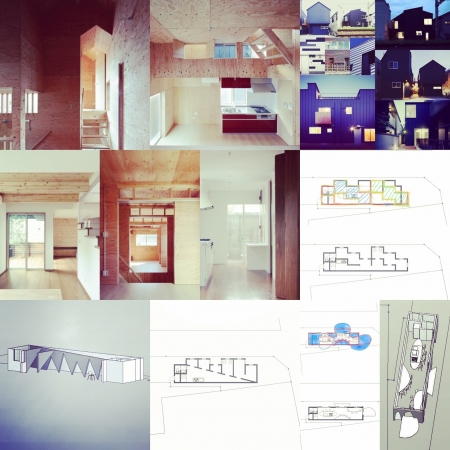建築が情報を与える
人よりも大きいスケールの建築は直接触れることができる部分が限られているので、離れたところから見て得られる情報から様々な判断をしており、居場所を決める時もその場所が滞在できる場所かを様々な情報から判断している。
その情報の中には慣習からくるものもあれば、その場のルールなどもあり、建築以外の社会性や倫理性などといった規範性も含まれるので、純粋に建築のみで決まることはないかもしれないが、建築はそのプランや形に社会性や倫理性を反映させるのが前提にはなっているので、しかし、今はその社会性や倫理性が明確ではなくプランや形につながる情報が無いように思われるが、建築が様々な情報を与えることにより人が居場所を選択するという図式が成り立つと考えることにする。
建築とは素材がある形になった物であり、そこに人がいなくても物としては存在する。しかし、建築は人が使う物であり、人が使わない物は工作物か廃墟であるから、そこに人との関係で建築を考える必要性が出てくる。そうすると、人が建築をどのように知覚し認識するかも含めてプランや形に人と建築の関係性を表現したい。
"Architecture gives information"
Buildings on a scale larger than humans have a limited number of parts that can be touched directly, so we make various judgments from information that can be seen from a distance, and when deciding where to stay, the place where we can stay. It is judged from various information.
Some of the information comes from customs, there are rules on the spot, and it also includes normatives such as sociality and ethics other than architecture, so it may not be decided purely by architecture alone. No, but architecture is premised on reflecting sociality and ethics in its plans and shapes, but now its sociality and ethics are not clear and there is no information that leads to plans and shapes. It seems, but I think that the scheme that a person chooses a place of residence is established by giving various information by architecture.
Architecture is a form of material that exists as a thing even if there are no people there. However, since architecture is something that people use, and things that people do not use are works or ruins, it becomes necessary to think about architecture in relation to people. Then, I would like to express the relationship between people and architecture in plans and shapes, including how people perceive and recognize architecture.


